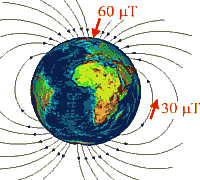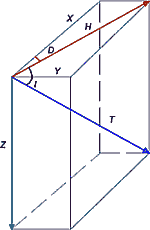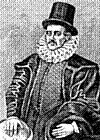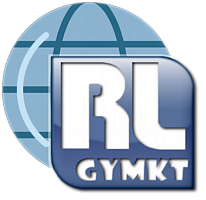Theory
Introduction
From childhood, almost everyone has known a compass to help them find their way in nature. Not everyone asks why the needle points only to the north. It is even possible that those who ask such a trivial question, with advancing technological development is decreasing. And yet it is one of the greatest mysteries of our planet, and not only his.

zdroj: http://stargazers.gsfc.nasa.gov/ resources/magnet_in_space.htm
The study of terrestrial magnetism has yielded valuable knowledge about the Earth and its evolution. The most complicated geomagnetic problem - the origin of the geomagnetic field – has been solved by a number of leading research teams and has been largely elucidated, but cannot be said to be solved. There is a general consensus that the Earth's magnetism comes from the area of the Earth's core, which is inside the Earth to a depth of 2900 km, and an outer layer of liquid, according to the results of seismology. The liquid outer core layer allows the solid mantle and crust to rotate relatively faster than the inner core. The electrons in the core to move the electrons because in the mantle and crust movement. It is this movement of electrons forms a kind of natural dynamo and the result is similar to the magnetic field that causes an electric coil
The compass needle points to a location that is somewhat farther from the geographic North and South Poles. The difference, called declination, varies from place to place. Small variations in the Earth's magnetism are probably caused by small currents or eddies in the outer core that formed when the core was in contact with the mantle. A large body of magnetic rocks and ores in the cortex may have a similar effect. The Earth's magnetic field is distorted by electrically charged particles from the Sun. These particles flow through the upper atmosphere and the ground, causing small fluctuations in the magnetic field. Some fluctuations are regular, such as day and night, while others are occasional, such as magnetic storms.
The intensity of the magnetic field
The intensity of the magnetic field (magnetic induction) is expressed in units of Tesla. The total intensity is about 50 μT. The direction of the geomagnetic field is also important. The north magnetic pole is perpendicular to the earth and in the Czech Republic it is oriented horizontally to the north at the equator. The total vector can be decomposed into individual components, as shown in Figure 1.

The vertical component Z points down, the horizontal component H points north. The directional component H deviates slightly from the geographic meridian because the geomagnetic pole is not identical to the geographic pole. The angle between the direction of the geomagnetic field H and the geographical meridian is called the magnetic declination D. For example, in the Czech Republic the compass declination deviates by about 2.5° from the north-south direction to the northeast (with the apparent shift of the north magnetic pole is about 6' to the east of the year).
The angle between the direction vector and the total horizontal component is called the magnetic inclination I, and here it is about 65°.

Fig. 1 - Definition of components of the geomagnetic field.
Sometimes the orthogonal components of the geomagnetic field, X (north) and Y (east) are used, as shown in Figure 1.
- Note:
- To illustrate the size of the individual components, which are not shown to scale, the Y component is greatly enlarged and the Z component is greatly reduced.
History of the Measurement of the Earth's Magnetism
Effects of an unknown force on the magnet aroused the interest of scholars in antiquity. It is evident from such an encyclopedic work "Naturalis historia" of C. Plinius, older, who lived in the 1st century after Christ. Moreover, the word "magnet" comes from ancient times: Magnetite was then called "lapis Magnes" the ancient city of Magnesia, where its site.
In the Middle Ages, the phenomenon of magnetism inspired one of the first great works of experimental research, an essay entitled "Epistola Petri Peregrini de Maricourt ad Sygarum de Foucancourt, militem, de magnete". Petrus Peregrinus, who lived in the 13th century, was a French scholar and soldier. In his "Letter about the Magnet" was first defined the nature of the dipolar magnet, described the interaction between the poles and equipment that allow the use of the magnet. Refuted the idea that the magnetic compass needle is attracted to the mountains, which are supposed to exist somewhere in the north. Peregrina be considered the forerunner of the creators of modern scientific methodology.

William Gilbert
Another great scientist who studied the Earth's magnetism was William Gilbert, an English physician to Queen Elizabeth I. Wrote in 1600 and published a comprehensive monograph whose long name begins with "De magnete". Although he had a rather small number of measurements of the direction of the Earth's field, made the absolutely correct conclusion: the Earth's magnetic field is analogous to its spatial arrangement of the ball field, magnetite, and therefore: The Earth itself is a great magnet.

Edmond Halley
Earth's magnetism is also known astronomer Edmond Halley. He organized two research cruises across the Atlantic Ocean to study in detail how we change the direction of the magnetic needle. It had long been known in his time that the compass did not point exactly north, and that its deviation from north (magnetic declination) varied from place to place. Halley recognized that some elements of the Earth's magnetism shift with time to the west, and from this with remarkable prescience concluded that the Earth has a "core", which is the bearer of magnetism, and that this core is in arrears in the rotation of the outer layer of the Earth. Their findings were published in 1698, but were then met with a positive response. Today it is clear that his ideas were very close to the truth.

Carl Friedrich Gauss
The knowledge of the geomagnetic field has contributed substantially famous mathematician and physicist Carl Friedrich Gauss. Prepared by a mathematical procedure that allows to calculate the geomagnetic vector at any point on the Earth or above it, if we have a finite number of measurements (Alexander von Humboldt brought Gauss geomagnetic field measured values from different regions of the world, when Humboldt studied the Earth's magnetism on their scientific research vessels). The Gauss process can also tell whether the geomagnetic field is energized only within the country or even beyond. This work was published by Gauss in 1839 in his book "Allgemeine therie des Erdmagnetismus" (General Theory of the Earth's magnetism).
Gaussian process showed that the bulk of the geomagnetic field (about 90 %) is as if it attracted the elementary magnetic dipole. This term we can bring a little inaccurate idea of bar magnet. The dipole is located approximately in the center of the Earth and its axis forms a small angle (currently it is about 11°). Gilbert's statement that the Earth itself is a magnet received this mathematical confirmation.











